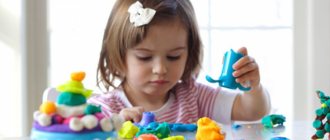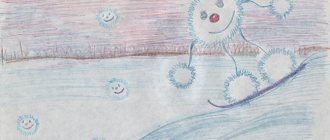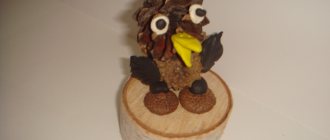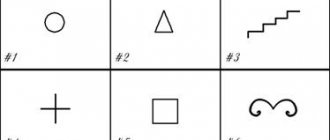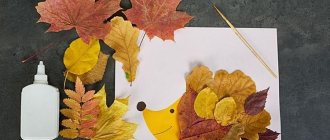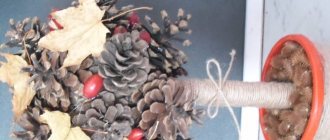Creative experiments in the country
During your summer holiday in the village with your grandmother or at the dacha, you can also have a great time on a rainy day or in the garden, in the fresh air, creating wonderful craft toys from garbage with your own hands.
It is very simple, and the materials, traditionally, will be useful only in the most primitive ways. The main thing is ingenuity and imagination. What you can do with children:
- a town with houses for fairies;
- ladybugs, bees;
- garlands for home and garden;
- mailbox decorations;
- decorations for trees and fences.
You can use anything that comes to mind and that you don’t mind for crafts made from waste materials. For example, the basis of many designs will be 0.5 liter plastic bottles; you also need paints, paper flowers, glue, scissors, yoghurt and kinder surprise cases. Paint the bottles, make a cut in the center and cut out windows. You can stick pieces of cardboard on top, imitating brickwork.
Fill the fairy house with toys and accessories, also made by yourself. And the design of a garden, fence, barn or dog house can be entrusted to children - let them paint and decorate the space themselves.
Stages of creation
If you are working on a creative recycled craft project with your child, try to instill in him the habit of thinking freely, but constructively, in accordance with the logic of the process. The stages of work can be as follows:
- The idea of creating a new toy. You can take a ready-made example as a basis, choose from a picture or photograph. Analyze with your child the features of the chosen option - what is the complexity, what materials are needed, what parts are the main ones.
- Consider the design details - fastenings, reliability of connections, safety of glue.
- Check the availability of coloring materials (markers, pencils, paints), if necessary, as well as decorations.
- Consider techniques that will be convenient and useful: modeling, applique, embroidery.
- Prepare the material and start cutting, cutting, sewing and planing parts.
- Engage in fastening the parts, check the strength of the connections.
- The finished product can be demonstrated to an audience, analyzed and discussed with children.
Show your child how to do this or that technique so that he gradually masters it and begins to work independently. Explain what needs to be done and why at each stage. In this way, children will learn to plan the entire process, have a holistic perception of work, and will more accurately strive for results.
Important: do not criticize children if something does not work out, otherwise the joy of participating in a creative project will disappear.
It is worth considering the age of the children; there is no need to expect too much from little masters. To prevent them from getting bored, it is important to encourage them and praise them for every successful step.
Cloth
You can also make interesting and funny clothing models from waste - DIY crafts from waste material. Make a dress for a girl from newspapers, bags, cups or plates. Do fittings, catwalks and fashion shows, it’s fun and greatly develops the imagination of future fashion designers, teaches outside-the-box thinking.
How to make craft clothes from recycled materials or disposable tableware:
- first build a base of fabric or paper;
- stick on the decor parts;
- lay out the skirt using large pieces;
- the parts should be placed on top of each other diagonally so that the edges overlap;
- make “flashlight” sleeves from bent plates;
- Lay out the top layer of the dress with spoons, gluing them in layers (it’s better not to use forks, so as not to get scratched).
You can also make good dresses from canvas bags, as do crafts from garbage. You can make a whole theatrical production with actors in the roles of the goblin, the Scarecrow, the Woodcutter, and forest animals. The main thing is to have the basics in the form of shorts and T-shirts, the rest of the details are laid on top.
Now you know what crafts can be made from waste material for kindergarten. Do not limit the imagination of children, who will definitely get carried away by creativity. Crafts are a second life for unnecessary things for school and home. If they start generating their own ideas, then the day has not been wasted!
Craft materials
As a creative material you can use:
- plastic bottles and their caps of different colors and sizes;
- plastic plates, cups, forks, spoons, containers;
- traditional “natural material” - acorns, chestnuts, leaves, sticks, shells, plant seeds, pebbles, shells, etc.;
- various remnants of fabrics, beads, ribbons, braid, rhinestones, yarn, colored threads, etc.;
- traditional “children’s” materials: colored paper, cardboard, glue, colored pencils, felt-tip pens….
The list of materials used can be continued almost endlessly. In the skillful hands of masters and craftswomen there is a use for absolutely everything.
Senior Destad group
Crafts made from waste materials for older children and toys of a more complex level:
My house. Make an imitation of your home from boxes with appliqué, adding interesting details reminiscent of familiar interiors (curtains, lamps, beds, ladders).
Traffic light. Use matchboxes and add colored paper.
Fruit table. Cut different fruits and vegetables from foam rubber, cutting off corners and sharp edges.
Snowmen. Make rounded blanks from foam rubber and supplement them with paper elements.
Blue carriage for Gena and Cheburashka. Connect pre-made boxes-cars, make wheels from bottle caps. Paint the train or decorate the carriages with appliqué.
Snowdrops. Make flowers from sticks and candy wrappers, tying them with thread.
Boxes-typewriters. Cover different boxes with paper wheels and bodies, write the name of the car brand, add appliques and modeling.
Gymnasts. Make figures from flexible wire wrapped in PVC. Roll colored paper on top and paint the faces of the gymnasts.
City at Christmas. You can make a large-scale model of a town with towers, houses, shops. For this purpose, juice bags, spray paint, markers and glue will come in handy.
Additional tools
For successful work, it is important to prepare everything you need in advance. Traditionally, “waste” creativity uses:
- scissors;
- glue gun;
- scotch;
- hole punchers, pliers, round nose pliers,
- needle, thread
The list of auxiliary materials, of course, can be continued. The main thing is to prepare everything in advance so as not to be distracted while working.


